Judy Natal will visit the Light Work booth during Art Chicago, held this year April 29-May 2, 2011, to talk about her work and sign copies of Contact Sheet 126. Stay tuned for more information on that event, and in the meantime, get to know Natal by reading this story about her experience running an Open Studio at Biosphere 2.
From November 1, 2010 to March 1, 2011, I created an Open Studio at the Biosphere 2 in Oracle, Arizona. I have been working at the Biosphere 2 on and off since I first set eyes on the place as a tourist taking a guided tour while attending a friend’s wedding in Tucson in June 2007. It was love at first sight! It is such a spectacularly peculiar place with a sordid past and a present and future of enormous promise where BIG science is now taking place, particularly around the issues of water. Which makes sense, when you consider that it is nestled in the beautiful Canyon del Oro, in the foothills of the Santa Catalina Mountains on the edge of the great Sonoran Desert.
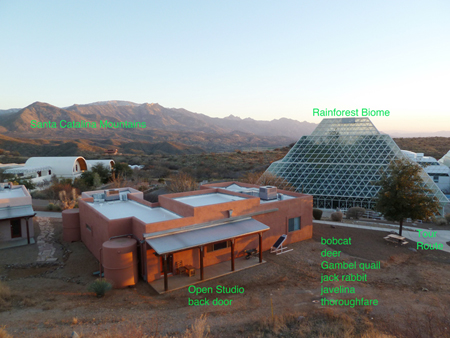
The Biospherians created Biosphere 2 to explore space colonization. It was an enormous engineering feat, with five ecosystems under 66,000 panes of glass, and eight humans (with all the accompanying psycho-drama) sealed within the airtight facility for two years between 1991-1993. (See Biospherian Jayne Poynter’s account in her book The Human Experiment. It’s a page turner!). All the while, growing their own food, filtering their own waste and water, and orchestrating five ecosystems.
At the time of my visit, I had begun what has now become a four-year project, Future Perfect, that entails a photographic sweep of three peculiarly evocative sites where human intervention and land use are exploring the quality and state of futurity, illuminating the present moment and the choices we have yet to make.
Immediately upon my return from visiting Tucson and Biosphere 2, I proposed an artist residency there, and I have been working with Biosphere 2 ever since in a mutually beneficial relationship, helping to establish a residency program in 2008.
When I arrived at Biosphere 2 in November 2010, I knew my time was going to be different. Unlike my previous residencies at Biosphere 2, when I was in the field photographing every minute possible, I now had the intention of setting up an Open Studio, with an expectation of proofing, printing, editing, and sequencing the hundreds of photographs that I had made to date, with the goal of printing the work for exhibition and publication. With this realization, I proposed opening up my art practice to the hundreds of visitors who come to Biosphere 2 seven days a week. The B2 Institute Director Pierre Meystre, who I developed and enjoyed a supportive relationship with (this is key!), gave his enthusiastic support to my proposal, which placed a public face on the artist residency program. The interaction with the general public was enlightening and helped me hone my ability to speak about my new body of work. It also facilitated an ongoing dialogue about imagining the future, which was a primary goal for the project.
Immediately upon my arrival, I ordered wallboards that the maintenance staff helped me paint and install in the casita where I stayed. Within a day and a half of my arrival, the wallboards were up, prints were pinned to the wall, the two inkjet printers I brought with me were plugged in, the door was open (it’s winter in Arizona after all), and a sign welcoming Biosphere 2 visitors was up.
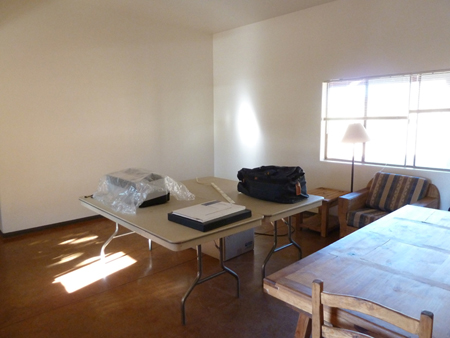
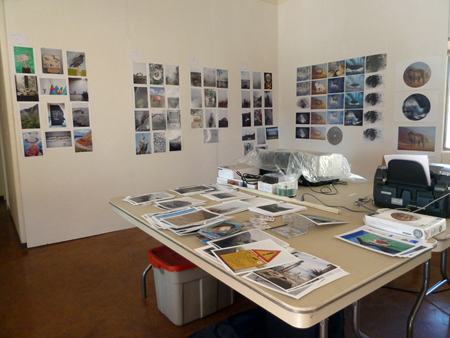
The ensuing four months were a gift, a unique opportunity, and a challenge. I began a series of photographic portraits of people who visited the Open Studio, which included staff, students, tour guides, and visitors from every walk of life. Nobel laureate scientists, poets, artists, photographers, writers, grad and under grad students, faculty, research assistants, engineers, k-12 classes, the American Boys Choir (accompanied by a brief concert), even one of my own students from Columbia College visited.
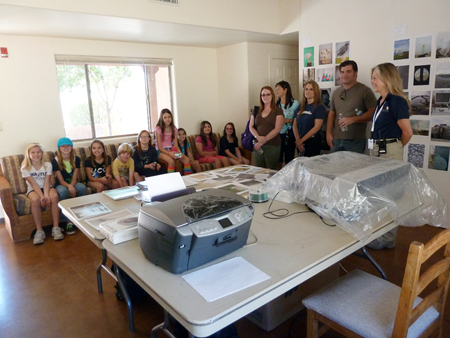
I also created a new body of work, now a limited edition portfolio of 35 prints, entitled Astral Projections, inspired by the writings of the renown biologist Edward O. Wilson, on the loss of biodiversity and animal extinction. This work was playful and full of color, and it relieved the tedium of proofing and printing.
The interruptions that happen at an Open Studio did take some getting used to, and I did feel like a bit of a broken record as I explained my work for each tour cycle. But I was surprisingly rewarded by the interactions, and I simply pulled my sign in when I needed a break. By 5pm, when the tours finished for the day, a beautiful calm, not to mention spectacular sunsets, descended on Biosphere 2, the only place of its kind, and what Life magazine called “one of the contemporary wonders” in the world. I am quite a solitary creature while I’m photographing and working, so this was a new experience for me. It was incredibly rich, endlessly surprising, and has me thinking about how I can do this in my studio in Chicago. I invite you to try it! —Judy Natal
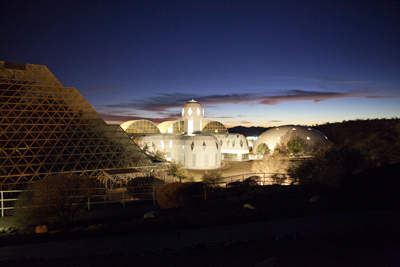
Judy Natal was an Artist-in-Residence at Light Work in 2003, and her work was featured in an exhibition in the Light Work Main Gallery in 2004. Natal is a professor of photography at Columbia College in Chicago. Her work is the collection of institutions including the California Museum of Photography, Center for Creative Photography, and the Museum of Contemporary Photography, among many others. Her work has been exhibited at Projects International, The Nelson-Atkins Museum, and the Sao Paulo Biennial, among other venues.
See you in Chicago
/in NewsOver the course of the fair, we’ve invited three former Light Work Artists-in-Residence to stop by the booth, talk about their work, and share their experiences about being a resident at Light Work. Make sure to stop by and meet:
Kelli Connell, Friday, April 29, 2-3pm
 Kelli Connell was a Light Work Artist-in-Residence in 2008. Connell received her MFA in photography from Texas Woman’s University, and her BFA in both photography and visual art studies from the University of North Texas. Her work has been exhibited nationwide. Connell has also received various awards and residencies, and given lectures and workshops across the country. Connell currently teaches at Columbia College in Chicago. For more information about Kelli Connell please visit her website.
Kelli Connell was a Light Work Artist-in-Residence in 2008. Connell received her MFA in photography from Texas Woman’s University, and her BFA in both photography and visual art studies from the University of North Texas. Her work has been exhibited nationwide. Connell has also received various awards and residencies, and given lectures and workshops across the country. Connell currently teaches at Columbia College in Chicago. For more information about Kelli Connell please visit her website.
Judy Natal, Saturday, April 30, 1pm
Judy Natal was an Artist-in-Residence at Light Work in 2003, and her work was featured in an exhibition in the Light Work Main Gallery in 2004. Natal is a professor of photography at Columbia College in Chicago. Her work is the collection of institutions including the California Museum of Photography, Center for Creative Photography, and the Museum of Contemporary Photography, among many others. Her work has been exhibited at Projects International, The Nelson-Atkins Museum, and the Sao Paulo Biennial, among other venues. For more information about Judy Natal and her work, please visit her website.
Dawoud Bey, Sunday, May 1, 1pm
Dawoud Bey was a Light Work Artist-in-Resdidence in 1985. His work was featured in an exhibition in the Light Work Main Gallery in 1986, and his work is included in the Eatonville Portfolio. His work has been exhibited at numerous institutions worldwide, including The Art Institute of Chicago, The Barbican Centre in London, the Los Angeles County Museum of Art, and the Whitney Museum of American Art, among many others. For more information about Dawoud Bey, please visit his website.
See you at the fair!
Enjoy the Contact Sheet Digital Archive today
/in NewsOver 160 issues of Contact Sheet are available online in our Digital Archive. If you currently subscribe to Contact Sheet, all you have to do is sign in for immediate access to the Archive. You can subscribe online – if you’d like to go entirely paperless, you can get online-only access to every Contact Sheet ever printed for $25. Our free trial subscription allows you to peruse the most recent issues of Contact Sheet, including the Light Work Annual. Click here for a quick preview and find out how easy it is to use the Contact Sheet Digital Archive. Let us know (315.443.1300; info@lightwork.org) if you have any questions about how to access this amazing resource.
Contact Sheet 161, the latest to be added to the Digital Archive, features the work of Jeffrey Henson Scales, whose exhibition That Year of Living is also currently on view in the Light Work Main Gallery.
From the Juror, Amber Terranova
/in NewsMore than 50 Syracuse University students entered the Light Work Student Invitational this year. Photo District News photo editor Amber Terranova served as our juror to select a Best of Show winner, Genevieve Marshall, and Honorable Mention award recipients Andrew Hida and Renée Stevens. An exhibition featuring the work of all those who entered is currently on view on the Light Work flat screen. Congratulations to the winners, and our thanks to all participants and our juror.
Juror’s statement by Amber Terranova
A number of themes recurred in the Light Work Student Invitational, including identity, love, loneliness, and the beauty of nature. I was particularly struck by the connection between photographer and subject in much of the work. Images of family dynamics, couples, moments between young lovers and friends, celebration, objects, religion, nature, empty urban and interior spaces all seem to permeate the open invitational this year. In this particular invitational the individual images had to make an immediate impression since the call wasn’t for series. While editing the selections I began to take notice of imagery that revealed the photographers’ unique perspective or an intention. Technically proficient images reflecting a strong concept or aesthetic stood out.
Many of the students’ images appealed to me and felt fresh. But I was drawn to Genevieve Marshall’s portrait (above), the recipient of the 2011 Best of Show Award. Her image offers room for a viewer’s interpretation. The gentle light, muted colors, gesture, and subtle eye contact suggest a certain curiosity about her subject. This image also emphasizes the importance of timing. To capture spontaneous moments requires being observant and quick. Here, Marshall’s choice of focus and perspective create both intimacy and distance. It’s a moment that raises questions or hints at something to come.
Amber Terranova is the photo editor for Photo District News. She worked previously for New York magazine and Outside. Amber has reviewed portfolios for the New York Photo Festival, the International Center of Photography, Review LA, Review Santa Fe, Photo NOLA, the Boulder Magazine Conference, Aurora photography, APA, and has been a guest lecturer at ICP, SVA, MICA (Baltimore) and Dawson College in Montreal. She has judged national photo contests, serving in 2009 as one of three jurors for Review Santa Fe and in 2010 as a judge for the International Photography Awards. She also judged The Center for Fine Art Photography’s Red competition and an issue of F-Stop magazine.
Students Participating in the 2011 Student Invitational Exhibition:
Daniel Aguilera, Sarah Anthony, Martin Biando, Danielle Carrick, Caitlin Caspersen, Luis Chimbo, Kathryn Connelly, Maureen Coyle, Ciara Crocker, Rose Cromwell, Brian Dawson, Joshua L. DeMotts, Emily Edwards, Jillian Ellis, Julia Ferrier, Amy Francisco, Andrew Frost, Anthony Garito, Andrew Hida, Mark Hoelscher, Myron Holmes, Robert Hopkins, Max Jackson, Lauren Jones, Varun Joshi, Jenna Ketchmark, John Liau, Joe Lingeman, Robert Loughlin, Annie Louton, Allie Marino, Genevieve Marshall, Varvara Mikushkina, Bob Miller, Emma Morgan Meade, Hannah Nast, John O’Toole, Arundhati Patel, Carly Piersol, Elizabeth Reyes, Jessica Scarfo, Meghan Schaetzle, Masha Snitkovsky, Renée Stevens, Leah Stiles, Alyssa Stone, Bridget Streeter, Chris Trigaux, David Trotman-Wilkins, Jennifer Turner, Tracey Wishik, and Elif Yoney.
Images: Top, Genevieve Marshall, recipient of the 2011 Best of Show Award; middle, Andrew Hida, recipient of the 2011 Honorable Mention Award; bottom, Renée Stevens, recipient of the 2011 Honorable Mention Award.
Jeffrey Henson Scales Interview
/in ElsewhereThat Year of Living, an exhibition of work by Jeffrey Henson Scales, will be on view at the Light Work Main Gallery until May 27. Click here to read more about this amazing series, which was made in the time after Scales had been diagnosed and successfully treated for cancer.
Before the opening reception for the show yesterday, Scales gave an interview about his work to WSYR. In the interview, Scales also talks about what makes a good photograph, making work on the streets of Manhattan, and his #1 tip for taking pictures (take a lot of them!).
Thilde Jensen speaks about art and illness
/in NewsThilde Jensen talks about her series Canaries in this great interview with Syracuse University Goldring student Lily Betjeman. An exhibition of Canaries, which depicts people living with Multiple Chemical Sensitivity, is currently on view at Light Work until May 27.
Canaries from Light Work on Vimeo.
Studio Visit: Judy Natal
/in Studio VisitJudy Natal will visit the Light Work booth during Art Chicago, held this year April 29-May 2, 2011, to talk about her work and sign copies of Contact Sheet 126. Stay tuned for more information on that event, and in the meantime, get to know Natal by reading this story about her experience running an Open Studio at Biosphere 2.
From November 1, 2010 to March 1, 2011, I created an Open Studio at the Biosphere 2 in Oracle, Arizona. I have been working at the Biosphere 2 on and off since I first set eyes on the place as a tourist taking a guided tour while attending a friend’s wedding in Tucson in June 2007. It was love at first sight! It is such a spectacularly peculiar place with a sordid past and a present and future of enormous promise where BIG science is now taking place, particularly around the issues of water. Which makes sense, when you consider that it is nestled in the beautiful Canyon del Oro, in the foothills of the Santa Catalina Mountains on the edge of the great Sonoran Desert.
The Biospherians created Biosphere 2 to explore space colonization. It was an enormous engineering feat, with five ecosystems under 66,000 panes of glass, and eight humans (with all the accompanying psycho-drama) sealed within the airtight facility for two years between 1991-1993. (See Biospherian Jayne Poynter’s account in her book The Human Experiment. It’s a page turner!). All the while, growing their own food, filtering their own waste and water, and orchestrating five ecosystems.
At the time of my visit, I had begun what has now become a four-year project, Future Perfect, that entails a photographic sweep of three peculiarly evocative sites where human intervention and land use are exploring the quality and state of futurity, illuminating the present moment and the choices we have yet to make.
Immediately upon my return from visiting Tucson and Biosphere 2, I proposed an artist residency there, and I have been working with Biosphere 2 ever since in a mutually beneficial relationship, helping to establish a residency program in 2008.
When I arrived at Biosphere 2 in November 2010, I knew my time was going to be different. Unlike my previous residencies at Biosphere 2, when I was in the field photographing every minute possible, I now had the intention of setting up an Open Studio, with an expectation of proofing, printing, editing, and sequencing the hundreds of photographs that I had made to date, with the goal of printing the work for exhibition and publication. With this realization, I proposed opening up my art practice to the hundreds of visitors who come to Biosphere 2 seven days a week. The B2 Institute Director Pierre Meystre, who I developed and enjoyed a supportive relationship with (this is key!), gave his enthusiastic support to my proposal, which placed a public face on the artist residency program. The interaction with the general public was enlightening and helped me hone my ability to speak about my new body of work. It also facilitated an ongoing dialogue about imagining the future, which was a primary goal for the project.
Immediately upon my arrival, I ordered wallboards that the maintenance staff helped me paint and install in the casita where I stayed. Within a day and a half of my arrival, the wallboards were up, prints were pinned to the wall, the two inkjet printers I brought with me were plugged in, the door was open (it’s winter in Arizona after all), and a sign welcoming Biosphere 2 visitors was up.
The ensuing four months were a gift, a unique opportunity, and a challenge. I began a series of photographic portraits of people who visited the Open Studio, which included staff, students, tour guides, and visitors from every walk of life. Nobel laureate scientists, poets, artists, photographers, writers, grad and under grad students, faculty, research assistants, engineers, k-12 classes, the American Boys Choir (accompanied by a brief concert), even one of my own students from Columbia College visited.
I also created a new body of work, now a limited edition portfolio of 35 prints, entitled Astral Projections, inspired by the writings of the renown biologist Edward O. Wilson, on the loss of biodiversity and animal extinction. This work was playful and full of color, and it relieved the tedium of proofing and printing.
The interruptions that happen at an Open Studio did take some getting used to, and I did feel like a bit of a broken record as I explained my work for each tour cycle. But I was surprisingly rewarded by the interactions, and I simply pulled my sign in when I needed a break. By 5pm, when the tours finished for the day, a beautiful calm, not to mention spectacular sunsets, descended on Biosphere 2, the only place of its kind, and what Life magazine called “one of the contemporary wonders” in the world. I am quite a solitary creature while I’m photographing and working, so this was a new experience for me. It was incredibly rich, endlessly surprising, and has me thinking about how I can do this in my studio in Chicago. I invite you to try it! —Judy Natal
Judy Natal was an Artist-in-Residence at Light Work in 2003, and her work was featured in an exhibition in the Light Work Main Gallery in 2004. Natal is a professor of photography at Columbia College in Chicago. Her work is the collection of institutions including the California Museum of Photography, Center for Creative Photography, and the Museum of Contemporary Photography, among many others. Her work has been exhibited at Projects International, The Nelson-Atkins Museum, and the Sao Paulo Biennial, among other venues.
Jeffrey Henson Scales: That Year of Living
/in ExhibitionsLight Work is pleased to announce the exhibition That Year of Living featuring stunning black-and-white photographs by Jeffrey Henson Scales. Diagnosed with cancer in 2008, Scales was forced to, in his words, weigh the possibilities of his own demise, and whether he had achieved what he felt he was put here to do. It was this diagnosis and contemplation, along with the urging of his wife, Meg Henson Scales, which led him to return to making photographs on a daily basis.
The images in That Year of Living were made in the year following his cancer diagnosis and surgery. Scales photographed mainly in and around Times Square, depicting the part of New York City that he visited every day going to and from work at The New York Times. The images capture the certain hardness mixed with joy, sadness, determination, and bewilderment that is found in the faces of young and old alike in New York City. Created in the months following his own experience with mortality, the photographs explore the journey of life and death found in the faces on the streets of New York.
According to Scales, “I believe the world outside is never a static experience. Life on the street in New York City is always changing and I have and always will love to see what it looks like, photographed. I never bore of the state of contemporary life as it is reflected in the faces of people, the states of nature, the stuff of life itself. As such, I hope to always be making photographs of this thing: life—even when it transmogrifies into its natural endpoint.”
About the Artist
Scales has spent more than forty years as a documentary photographer. His work has been exhibited internationally, and has appeared in numerous photography books, magazines, and anthologies. His work is included in the permanent collections of The Museum of Modern Art, the George Eastman House, and the Baltimore Museum of Art. Scales has been a photography editor for The New York Times since 1998, editing The Week in Review, The Book Review, and co- editing The Year in Pictures. He is also an adjunct professor at the Tisch School of the Arts of New York University. He and his wife own the Harlem-based photo archive, HSP Archive, and the multimedia production company, Henson Scales Productions. His work can be viewed atwww.jeffreyscales.com.
Also on view at this time is Canaries, an exhibition of photographs by Thilde Jensen. The images in this exhibition are a personal account of the life Jensen has lived with Multiple Chemical Sensitivity, and the people she has met who suffer the same condition. People with this sensitivity have been dubbed “human canaries,” and they are the casualties of what Jensen calls a “ubiquitous synthetic chemical culture.” Jensen became so sensitive to chemicals in the air that she could not sit in traffic, read a book, or sit next to someone wearing perfume. She was forced to wear a gas mask when entering banks, supermarkets, and doctor’s offices. She left her life in New York City, her husband and her career, and moved to the country where she lived in a tent away from the regular chemicals such as laundry detergents, pesticides, and exhaust fumes.
Gallery hours for these exhibitions are Sunday to Friday, 10am-6pm, and by appointment. To schedule an appointment, please call 315-443-1300. Both the exhibition and reception are free and open to the public. Paid parking is available in Booth Parking Garage.
Light Work invites groups and individuals to schedule tours and gallery talks of the exhibition and facility. Light Work is a non-profit, artist-run organization dedicated to the support of artists working in photography and electronic media. Light Work is a member of CMAC, the Coalition of Museum and Art Centers at Syracuse University.
For more information, please contact Jessica H. Reed at Light Work, 315-443-1300 or jhreed01@syr.edu.
Thilde Jensen: Canaries
/in ExhibitionsLight Work is pleased to announce the exhibition Canary, an exhibition of photographs by Thilde Jensen. The images in this exhibition are a personal account of the life Jensen has lived with Multiple Chemical Sensitivity (MCS), and the people she has met who suffer the same condition.
Jensen, born in Denmark, moved to New York City in 1997 to study photography after an early exploration into film making. Six years later her life and career as a documentary and editorial photographer were cut short by a sudden development of severe MCS. The urban life she had previously navigated with ease transformed into a toxic war zone. Her immune system crashed, forcing her into a survivalist journey, unraveling the comfort and construct of her previous life. The ensuing years were a lesson in basic survival—camping in the woods and wearing a respirator when entering supermarkets, doctors’ offices, and banks.
To her surprise an otherwise invisible subculture of people emerged who shared this isolated existence. Photographing became a medium for sanity and meaning in this hyper-sensitive dimension of reality. Her photographs are a personal account of life on the edge of modern civilization as one of the human canaries, the first casualties to a ubiquitous synthetic chemical culture.
Since World War II the production and use of synthetic chemicals has exploded. During the course of an average day, people come into contact with a host of chemicals. Just walking into a supermarket one might be breathing as many as 20,000 different synthetic compounds. As a result of the prevalence of these synthetic chemicals, it is believed that more than 10 million Americans have developed MCS. Many people with MCS are forced to live in remote areas in tents, cars, or retro-fitted trailers, away from dangers of neighbors’ chemical use. Others are prisoners of their homes, with advanced air filter systems to keep outside air from contaminating their breathing space.
Gallery hours for this exhibition is Sunday to Friday, 10am–6pm, and by appointment. To schedule an appointment, please call 315-443-1300. Both the exhibition and reception are free and open to the public. Paid parking is available in Booth Parking Garage.
Light Work invites groups and individuals to schedule tours and gallery talks of the exhibition and facility. Light Work is a non-profit, artist-run organization dedicated to the support of artists working in photography and electronic media. Light Work is a member of CMAC, the Coalition of Museum and Art Centers at Syracuse University.
For more information, please contact Jessica Reed at Light Work, 315-443-1300 or jhreed01@syr.edu.
Best from the Rest: Lola Flash interview with Nono Osuji
/in ElsewhereCheck out this fantastic video interview of Lola Flash by Nono Osuji. Lola talks about many things, including being honest in your work as an artist, her first camera (a Minox), addressing racism and homophobia in her images, and the latest phase of her ongoing project Epicene.
Lola Flash was a Light Work Artist-in-Residence in 2008. Her work is featured in the Light Work Annual 152 and in the Light Work Collection.
2011 Light Work Artists-in-Residence
/in NewsCongratulations to the 2011 Light Work Artists-in-Residence, who were selected from an amazing pool of hundreds of applicants. Thanks to all who submitted materials and showed patience throughout the process.
We’re very pleased to host the following Artists-in-Residence in 2011:
Jen Davis
Amy Elkins
Sam Falls
Cui Fei
Shane Lavalette
Andrew Miksys
Sherry Millner
Dana Popa
Ohm Phanphiroj
Michael Tummings
Calla Thompson
Our renowned residency program features a $4,000 stipend, a free place to stay for the month, 24-hour access to our state-of-the-art facility, and generous staff support. Light Work was founded in 1973 as a non-profit, artist-run organization. We provide direct support to artists working in the media of photography and digital imaging through residencies, publications, exhibitions, a community-access digital lab facility, and other related projects.
Image: Michael Tummings, from the series Hidden